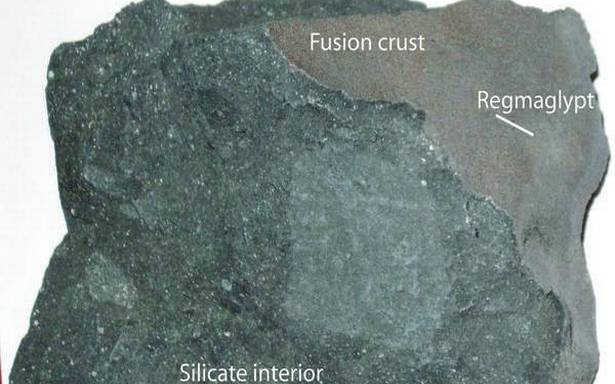It is a type of stony meteorite that is a remnant of the first solid bodies to accrete in the solar system
On June 6, 2017, at around 5 a.m., residents of Mukundpura village near Jaipur saw a bright trail in the sky followed by a thunderous sound. They spotted a burning object with a sulphur smell on the soft agricultural land.
The meteorite broke into several fragments, but a pit of about 15 cm in diameter and 10 cm in depth was formed at the impact site. The local police immediately collected it and handed it over to the Geological Survey of India, Kolkata. Now, a new study has shed light on the mineralogy of the meteorite.
Carbonaceous chondrite
The meteorite named Mukundpura CM2 was classified to be a carbonaceous chondrite. “This is a type of stony meteorite, considered the most primitive meteorite and a remnant of the first solid bodies to accrete in the solar system. The composition of carbonaceous chondrites are also similar to the Sun,” explains Dwijesh Ray from the Physical Research Laboratory, Ahmedabad in an email to The Hindu. He is the corresponding author of the work recently published in Geochemistry.
He adds that meteorites are broadly classified into three groups – stony (silicate-rich), iron (Fe–Ni alloy), and stony-iron (mixed silicate–iron alloy). Chondrites are silicate-droplet-bearing meteorites, and this Mukundpura chondrite is the fifth carbonaceous meteorite known to fall in India.
Degrees of alteration
The study revealed that Mukundpura CM2 had experienced varying degrees of alteration during the impact. Some minerals like forsterite and FeO olivine, calcium aluminium rich inclusion (CAI) minerals escaped alteration. Few magnetites, sulphides and calcites were also found. Detailed spectroscopic studies revealed that the meteorite had very high (about 90%) phyllosilicate minerals comprising both magnesium and iron. Further X-ray studies showed it also had aluminium complexes.
Relevance to asteroids
Dr. Ray adds that the results of the Mukundpura CM2 study are relevant to the surface composition of near-Earth asteroids Ryugu and Bennu. In October 2020, NASA’s OSIRIS-REx mission collected samples from Bennu and is expected to return in September 2023. Last month, Japan’s Hayabusa-2 mission landed on Earth with samples from Ryugu.
“Infrared spectroscopy results suggest that spectral properties of the surface of these asteroids are consistent with CM carbonaceous meteorites. Therefore, a better understanding of the nature and evolution of such meteorites that have been aqueously altered will help considerably in the interpretation of results of these missions,” he writes.
Early solar system
On being asked why it is important to study meteorites, Dr. Ray explains: “Meteorites are representative of asteroids. Asteroids are the remnant debris of the inner solar system formation process and thus offer the formation history or the building blocks of the planets. Therefore, by studying meteorites in the laboratory and asteroids by exploration and sample return mission we try to reconstruct the activity of early solar system events. Also, asteroids are often rich in volatiles and other minerals and can be exploited for future planetary exploration.”
This article is auto-generated by Algorithm Source: www.thehindu.com


